A Critical Appraisal of Health Practice Research Articles Report
VerifiedAdded on 2023/06/07
|16
|4727
|125
Report
AI Summary
This report presents a critical appraisal of two health practice articles, one quantitative and one qualitative, focusing on the reliability and applicability of research findings in the medical field. The quantitative study by Liang, Howard, and Wollersheim (2017) examines the competence of health service managers in evidence-informed decision-making, utilizing a cross-sectional design and SPSS for data analysis, highlighting the benefits of this approach while noting limitations such as abstract data and potential sample bias. The qualitative study by Savic et al. (2013) investigates the impact of family separation on Sudanese refugees' mental health in Australia, employing interviews and thematic analysis, emphasizing the value of in-depth information gathering but acknowledging challenges like time consumption and potential investigator bias. Both appraisals assess the strengths and weaknesses of each study, considering ethical issues and implications for health practice, ultimately providing insights into the credibility and transferability of the research findings.
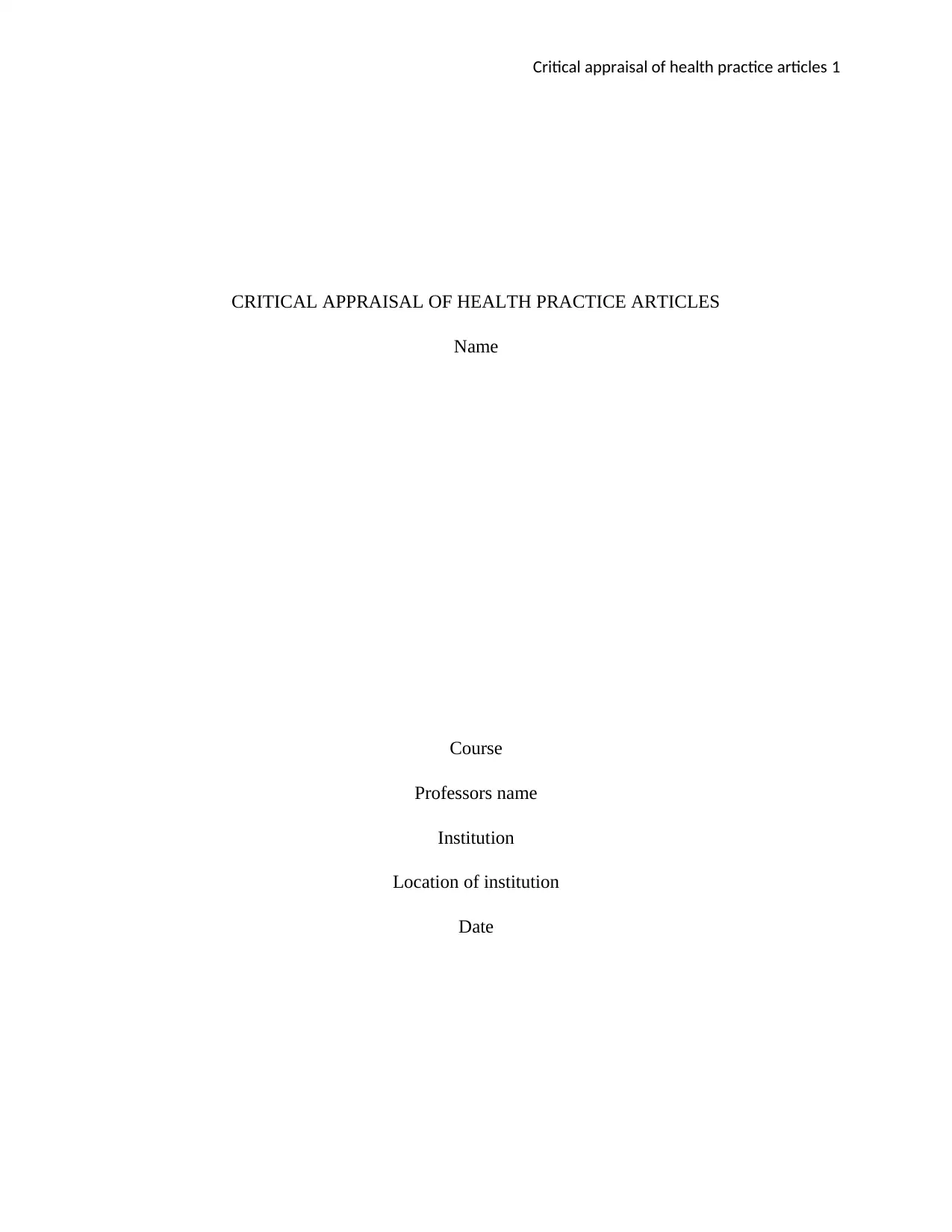
Critical appraisal of health practice articles 1
CRITICAL APPRAISAL OF HEALTH PRACTICE ARTICLES
Name
Course
Professors name
Institution
Location of institution
Date
CRITICAL APPRAISAL OF HEALTH PRACTICE ARTICLES
Name
Course
Professors name
Institution
Location of institution
Date
Paraphrase This Document
Need a fresh take? Get an instant paraphrase of this document with our AI Paraphraser
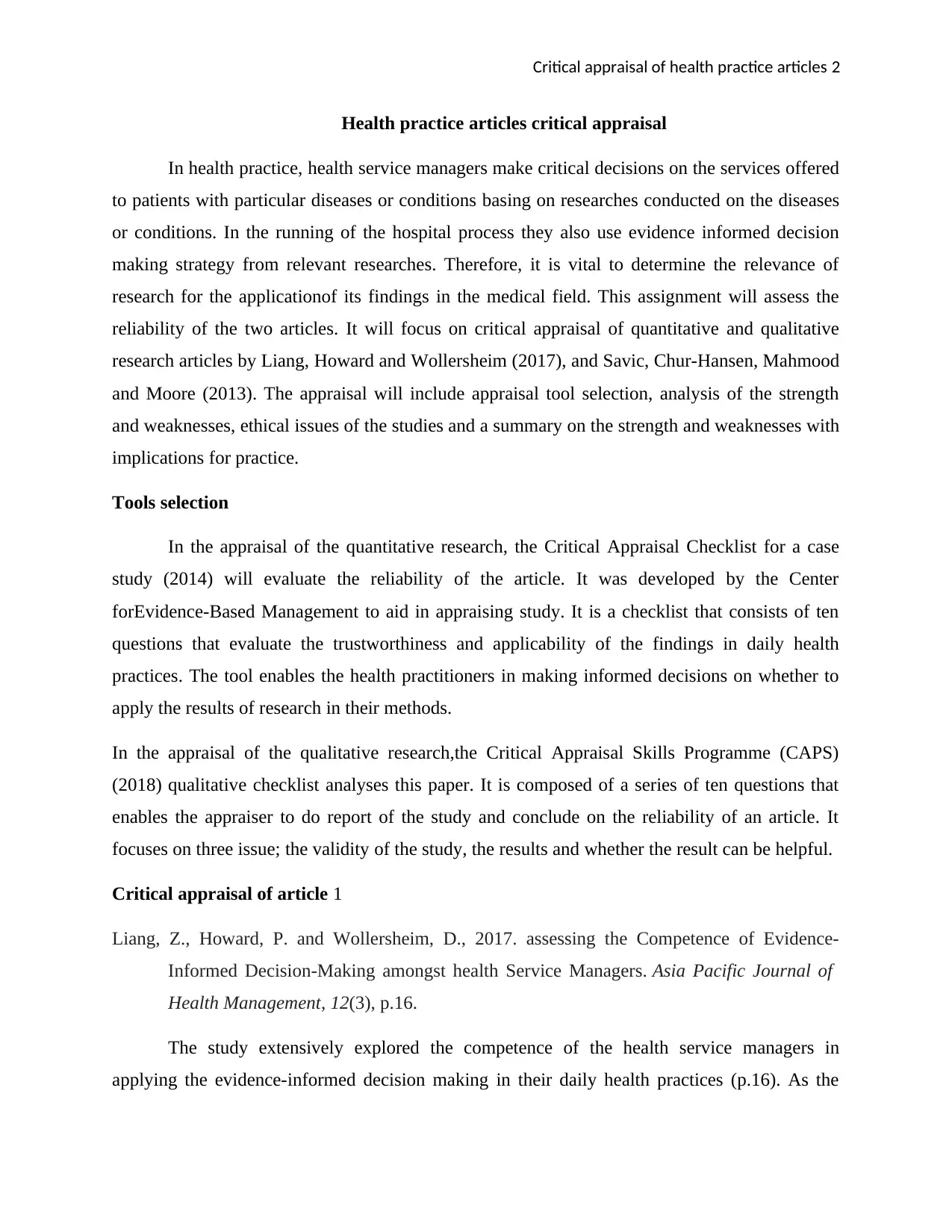
Critical appraisal of health practice articles 2
Health practice articles critical appraisal
In health practice, health service managers make critical decisions on the services offered
to patients with particular diseases or conditions basing on researches conducted on the diseases
or conditions. In the running of the hospital process they also use evidence informed decision
making strategy from relevant researches. Therefore, it is vital to determine the relevance of
research for the applicationof its findings in the medical field. This assignment will assess the
reliability of the two articles. It will focus on critical appraisal of quantitative and qualitative
research articles by Liang, Howard and Wollersheim (2017), and Savic, Chur-Hansen, Mahmood
and Moore (2013). The appraisal will include appraisal tool selection, analysis of the strength
and weaknesses, ethical issues of the studies and a summary on the strength and weaknesses with
implications for practice.
Tools selection
In the appraisal of the quantitative research, the Critical Appraisal Checklist for a case
study (2014) will evaluate the reliability of the article. It was developed by the Center
forEvidence-Based Management to aid in appraising study. It is a checklist that consists of ten
questions that evaluate the trustworthiness and applicability of the findings in daily health
practices. The tool enables the health practitioners in making informed decisions on whether to
apply the results of research in their methods.
In the appraisal of the qualitative research,the Critical Appraisal Skills Programme (CAPS)
(2018) qualitative checklist analyses this paper. It is composed of a series of ten questions that
enables the appraiser to do report of the study and conclude on the reliability of an article. It
focuses on three issue; the validity of the study, the results and whether the result can be helpful.
Critical appraisal of article 1
Liang, Z., Howard, P. and Wollersheim, D., 2017. assessing the Competence of Evidence-
Informed Decision-Making amongst health Service Managers. Asia Pacific Journal of
Health Management, 12(3), p.16.
The study extensively explored the competence of the health service managers in
applying the evidence-informed decision making in their daily health practices (p.16). As the
Health practice articles critical appraisal
In health practice, health service managers make critical decisions on the services offered
to patients with particular diseases or conditions basing on researches conducted on the diseases
or conditions. In the running of the hospital process they also use evidence informed decision
making strategy from relevant researches. Therefore, it is vital to determine the relevance of
research for the applicationof its findings in the medical field. This assignment will assess the
reliability of the two articles. It will focus on critical appraisal of quantitative and qualitative
research articles by Liang, Howard and Wollersheim (2017), and Savic, Chur-Hansen, Mahmood
and Moore (2013). The appraisal will include appraisal tool selection, analysis of the strength
and weaknesses, ethical issues of the studies and a summary on the strength and weaknesses with
implications for practice.
Tools selection
In the appraisal of the quantitative research, the Critical Appraisal Checklist for a case
study (2014) will evaluate the reliability of the article. It was developed by the Center
forEvidence-Based Management to aid in appraising study. It is a checklist that consists of ten
questions that evaluate the trustworthiness and applicability of the findings in daily health
practices. The tool enables the health practitioners in making informed decisions on whether to
apply the results of research in their methods.
In the appraisal of the qualitative research,the Critical Appraisal Skills Programme (CAPS)
(2018) qualitative checklist analyses this paper. It is composed of a series of ten questions that
enables the appraiser to do report of the study and conclude on the reliability of an article. It
focuses on three issue; the validity of the study, the results and whether the result can be helpful.
Critical appraisal of article 1
Liang, Z., Howard, P. and Wollersheim, D., 2017. assessing the Competence of Evidence-
Informed Decision-Making amongst health Service Managers. Asia Pacific Journal of
Health Management, 12(3), p.16.
The study extensively explored the competence of the health service managers in
applying the evidence-informed decision making in their daily health practices (p.16). As the

Critical appraisal of health practice articles 3
authors noted,utilization of evidence informed decision making by health service managers
enhances management and effective means of offering their services. The cross-sectional study
objective assessment design used in this study was appropriate since it enables the researchers to
focus on the set objective and not to focus on other related issues. As stated by Palinkas et al.
(2015), the study implementation varies based on the set priorities for the study.The study
involved two public hospitals and one hundred and thirty participants. Both the setting and the
subjects are representative of the target group. As affirmed by Gentles, Charles, Ploeg and
McKibbon (2015), in quantitative studies a larger sample size is fundamental for significant
statistical analysis and proper representation of the population (p.1773).In the study, the
researcher perspective was well described and considered. His central aspect was to determine
whether the health service managers and other health workers utilize the evidence-informed
decision making in their daily activity. The study focused on this and the information collected
was in line with the researcher perspective. Data wereobtained by the participants filling an
online questionnaire on the website that had been purposely designed by the researcher for data
collection and analysis.The data was analyzed using Statistical Package for the Social Science
(SPSS). The SPSS helps to analyze complex data (Bryman 2016). it reduces the researchers’
biasness and helps to draw the comparison of the data. The authors effectively described the data
analysis process, and this makes their data to be valid and reliable.However, the article does not
indicate whether the research was repeated by more than one researcher to enhance
reliability.The result obtained from the SPSS analysis is credible due to less or no investigator
biasness. It makes the results believable. The findings that indicated that the utilization of the
evidence-informed decision making promotes management is relevant to the health service
managers to do their duties without using alternative methods like experience to enhance
production.The findings of this study are well transferable to other settings for easy management
of their institutions and appropriately improving service delivery in health institutions.
Strength and weaknesses of the study
In this quantitative analysis, the study had several advantages that increased the
credibility and reliability. The research method was useful in gathering information that
enhances quantitative predictions. This will indicate the magnitude of the relevance of the
study.This research method was effective in study large sample size as compared to qualitative
authors noted,utilization of evidence informed decision making by health service managers
enhances management and effective means of offering their services. The cross-sectional study
objective assessment design used in this study was appropriate since it enables the researchers to
focus on the set objective and not to focus on other related issues. As stated by Palinkas et al.
(2015), the study implementation varies based on the set priorities for the study.The study
involved two public hospitals and one hundred and thirty participants. Both the setting and the
subjects are representative of the target group. As affirmed by Gentles, Charles, Ploeg and
McKibbon (2015), in quantitative studies a larger sample size is fundamental for significant
statistical analysis and proper representation of the population (p.1773).In the study, the
researcher perspective was well described and considered. His central aspect was to determine
whether the health service managers and other health workers utilize the evidence-informed
decision making in their daily activity. The study focused on this and the information collected
was in line with the researcher perspective. Data wereobtained by the participants filling an
online questionnaire on the website that had been purposely designed by the researcher for data
collection and analysis.The data was analyzed using Statistical Package for the Social Science
(SPSS). The SPSS helps to analyze complex data (Bryman 2016). it reduces the researchers’
biasness and helps to draw the comparison of the data. The authors effectively described the data
analysis process, and this makes their data to be valid and reliable.However, the article does not
indicate whether the research was repeated by more than one researcher to enhance
reliability.The result obtained from the SPSS analysis is credible due to less or no investigator
biasness. It makes the results believable. The findings that indicated that the utilization of the
evidence-informed decision making promotes management is relevant to the health service
managers to do their duties without using alternative methods like experience to enhance
production.The findings of this study are well transferable to other settings for easy management
of their institutions and appropriately improving service delivery in health institutions.
Strength and weaknesses of the study
In this quantitative analysis, the study had several advantages that increased the
credibility and reliability. The research method was useful in gathering information that
enhances quantitative predictions. This will indicate the magnitude of the relevance of the
study.This research method was effective in study large sample size as compared to qualitative
⊘ This is a preview!⊘
Do you want full access?
Subscribe today to unlock all pages.

Trusted by 1+ million students worldwide
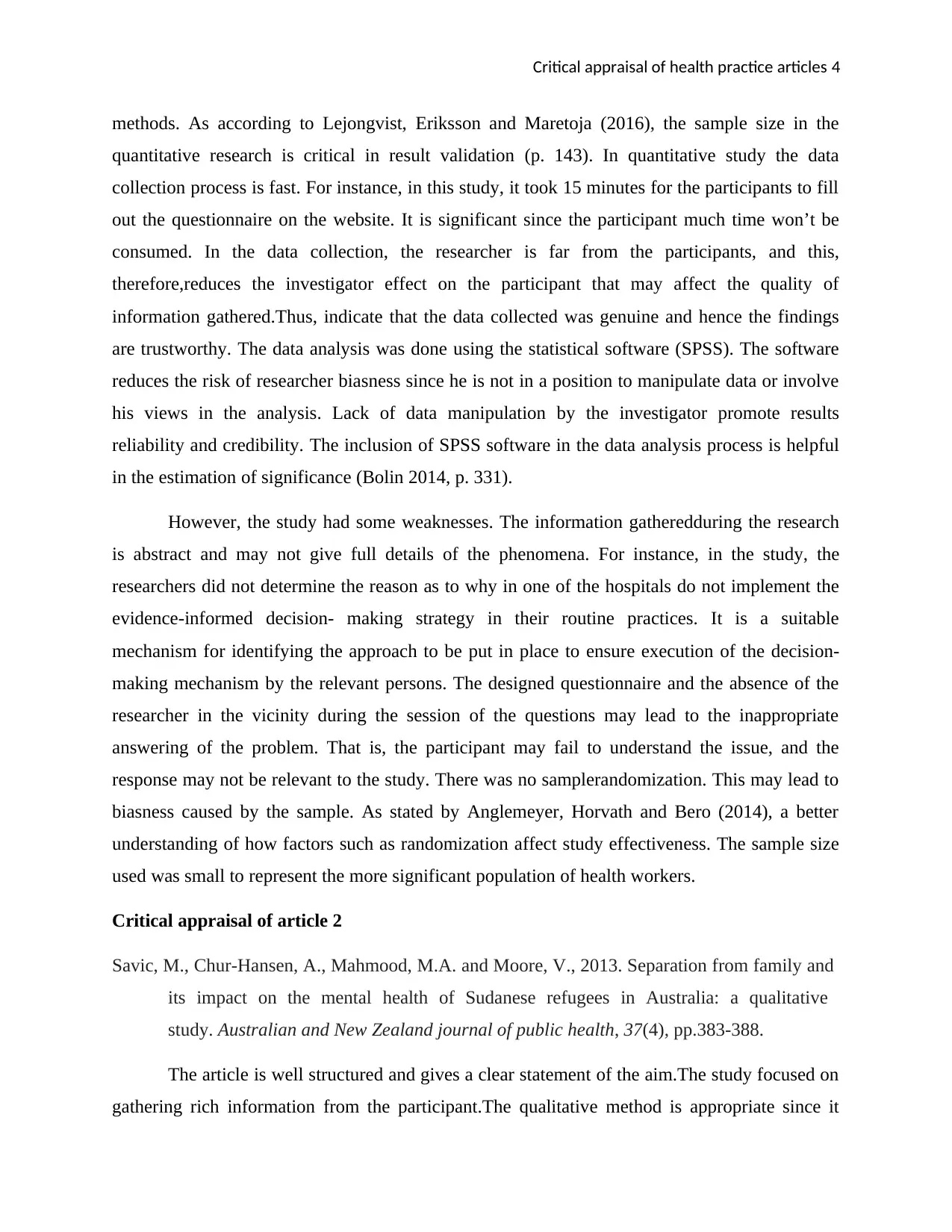
Critical appraisal of health practice articles 4
methods. As according to Lejongvist, Eriksson and Maretoja (2016), the sample size in the
quantitative research is critical in result validation (p. 143). In quantitative study the data
collection process is fast. For instance, in this study, it took 15 minutes for the participants to fill
out the questionnaire on the website. It is significant since the participant much time won’t be
consumed. In the data collection, the researcher is far from the participants, and this,
therefore,reduces the investigator effect on the participant that may affect the quality of
information gathered.Thus, indicate that the data collected was genuine and hence the findings
are trustworthy. The data analysis was done using the statistical software (SPSS). The software
reduces the risk of researcher biasness since he is not in a position to manipulate data or involve
his views in the analysis. Lack of data manipulation by the investigator promote results
reliability and credibility. The inclusion of SPSS software in the data analysis process is helpful
in the estimation of significance (Bolin 2014, p. 331).
However, the study had some weaknesses. The information gatheredduring the research
is abstract and may not give full details of the phenomena. For instance, in the study, the
researchers did not determine the reason as to why in one of the hospitals do not implement the
evidence-informed decision- making strategy in their routine practices. It is a suitable
mechanism for identifying the approach to be put in place to ensure execution of the decision-
making mechanism by the relevant persons. The designed questionnaire and the absence of the
researcher in the vicinity during the session of the questions may lead to the inappropriate
answering of the problem. That is, the participant may fail to understand the issue, and the
response may not be relevant to the study. There was no samplerandomization. This may lead to
biasness caused by the sample. As stated by Anglemeyer, Horvath and Bero (2014), a better
understanding of how factors such as randomization affect study effectiveness. The sample size
used was small to represent the more significant population of health workers.
Critical appraisal of article 2
Savic, M., Chur‐Hansen, A., Mahmood, M.A. and Moore, V., 2013. Separation from family and
its impact on the mental health of Sudanese refugees in Australia: a qualitative
study. Australian and New Zealand journal of public health, 37(4), pp.383-388.
The article is well structured and gives a clear statement of the aim.The study focused on
gathering rich information from the participant.The qualitative method is appropriate since it
methods. As according to Lejongvist, Eriksson and Maretoja (2016), the sample size in the
quantitative research is critical in result validation (p. 143). In quantitative study the data
collection process is fast. For instance, in this study, it took 15 minutes for the participants to fill
out the questionnaire on the website. It is significant since the participant much time won’t be
consumed. In the data collection, the researcher is far from the participants, and this,
therefore,reduces the investigator effect on the participant that may affect the quality of
information gathered.Thus, indicate that the data collected was genuine and hence the findings
are trustworthy. The data analysis was done using the statistical software (SPSS). The software
reduces the risk of researcher biasness since he is not in a position to manipulate data or involve
his views in the analysis. Lack of data manipulation by the investigator promote results
reliability and credibility. The inclusion of SPSS software in the data analysis process is helpful
in the estimation of significance (Bolin 2014, p. 331).
However, the study had some weaknesses. The information gatheredduring the research
is abstract and may not give full details of the phenomena. For instance, in the study, the
researchers did not determine the reason as to why in one of the hospitals do not implement the
evidence-informed decision- making strategy in their routine practices. It is a suitable
mechanism for identifying the approach to be put in place to ensure execution of the decision-
making mechanism by the relevant persons. The designed questionnaire and the absence of the
researcher in the vicinity during the session of the questions may lead to the inappropriate
answering of the problem. That is, the participant may fail to understand the issue, and the
response may not be relevant to the study. There was no samplerandomization. This may lead to
biasness caused by the sample. As stated by Anglemeyer, Horvath and Bero (2014), a better
understanding of how factors such as randomization affect study effectiveness. The sample size
used was small to represent the more significant population of health workers.
Critical appraisal of article 2
Savic, M., Chur‐Hansen, A., Mahmood, M.A. and Moore, V., 2013. Separation from family and
its impact on the mental health of Sudanese refugees in Australia: a qualitative
study. Australian and New Zealand journal of public health, 37(4), pp.383-388.
The article is well structured and gives a clear statement of the aim.The study focused on
gathering rich information from the participant.The qualitative method is appropriate since it
Paraphrase This Document
Need a fresh take? Get an instant paraphrase of this document with our AI Paraphraser
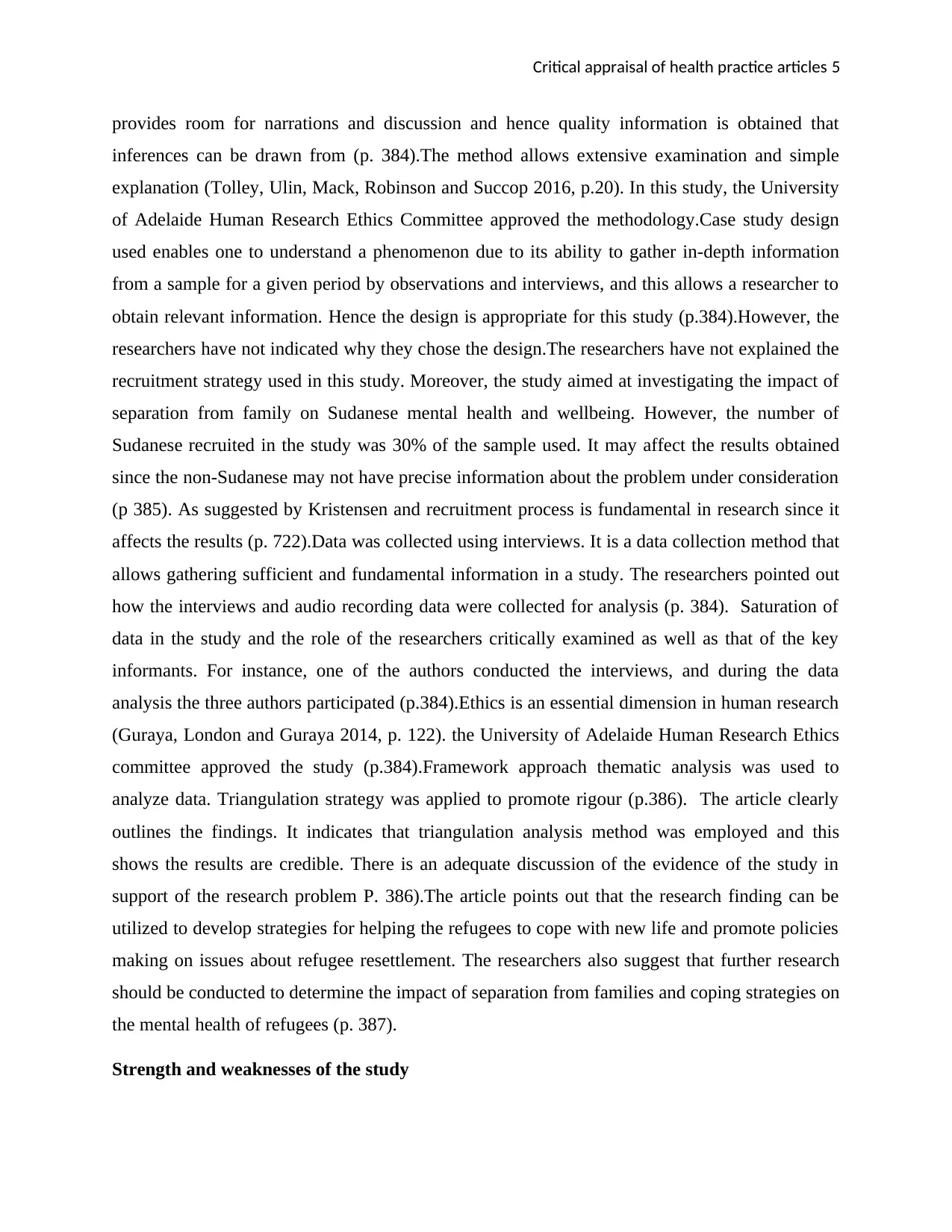
Critical appraisal of health practice articles 5
provides room for narrations and discussion and hence quality information is obtained that
inferences can be drawn from (p. 384).The method allows extensive examination and simple
explanation (Tolley, Ulin, Mack, Robinson and Succop 2016, p.20). In this study, the University
of Adelaide Human Research Ethics Committee approved the methodology.Case study design
used enables one to understand a phenomenon due to its ability to gather in-depth information
from a sample for a given period by observations and interviews, and this allows a researcher to
obtain relevant information. Hence the design is appropriate for this study (p.384).However, the
researchers have not indicated why they chose the design.The researchers have not explained the
recruitment strategy used in this study. Moreover, the study aimed at investigating the impact of
separation from family on Sudanese mental health and wellbeing. However, the number of
Sudanese recruited in the study was 30% of the sample used. It may affect the results obtained
since the non-Sudanese may not have precise information about the problem under consideration
(p 385). As suggested by Kristensen and recruitment process is fundamental in research since it
affects the results (p. 722).Data was collected using interviews. It is a data collection method that
allows gathering sufficient and fundamental information in a study. The researchers pointed out
how the interviews and audio recording data were collected for analysis (p. 384). Saturation of
data in the study and the role of the researchers critically examined as well as that of the key
informants. For instance, one of the authors conducted the interviews, and during the data
analysis the three authors participated (p.384).Ethics is an essential dimension in human research
(Guraya, London and Guraya 2014, p. 122). the University of Adelaide Human Research Ethics
committee approved the study (p.384).Framework approach thematic analysis was used to
analyze data. Triangulation strategy was applied to promote rigour (p.386). The article clearly
outlines the findings. It indicates that triangulation analysis method was employed and this
shows the results are credible. There is an adequate discussion of the evidence of the study in
support of the research problem P. 386).The article points out that the research finding can be
utilized to develop strategies for helping the refugees to cope with new life and promote policies
making on issues about refugee resettlement. The researchers also suggest that further research
should be conducted to determine the impact of separation from families and coping strategies on
the mental health of refugees (p. 387).
Strength and weaknesses of the study
provides room for narrations and discussion and hence quality information is obtained that
inferences can be drawn from (p. 384).The method allows extensive examination and simple
explanation (Tolley, Ulin, Mack, Robinson and Succop 2016, p.20). In this study, the University
of Adelaide Human Research Ethics Committee approved the methodology.Case study design
used enables one to understand a phenomenon due to its ability to gather in-depth information
from a sample for a given period by observations and interviews, and this allows a researcher to
obtain relevant information. Hence the design is appropriate for this study (p.384).However, the
researchers have not indicated why they chose the design.The researchers have not explained the
recruitment strategy used in this study. Moreover, the study aimed at investigating the impact of
separation from family on Sudanese mental health and wellbeing. However, the number of
Sudanese recruited in the study was 30% of the sample used. It may affect the results obtained
since the non-Sudanese may not have precise information about the problem under consideration
(p 385). As suggested by Kristensen and recruitment process is fundamental in research since it
affects the results (p. 722).Data was collected using interviews. It is a data collection method that
allows gathering sufficient and fundamental information in a study. The researchers pointed out
how the interviews and audio recording data were collected for analysis (p. 384). Saturation of
data in the study and the role of the researchers critically examined as well as that of the key
informants. For instance, one of the authors conducted the interviews, and during the data
analysis the three authors participated (p.384).Ethics is an essential dimension in human research
(Guraya, London and Guraya 2014, p. 122). the University of Adelaide Human Research Ethics
committee approved the study (p.384).Framework approach thematic analysis was used to
analyze data. Triangulation strategy was applied to promote rigour (p.386). The article clearly
outlines the findings. It indicates that triangulation analysis method was employed and this
shows the results are credible. There is an adequate discussion of the evidence of the study in
support of the research problem P. 386).The article points out that the research finding can be
utilized to develop strategies for helping the refugees to cope with new life and promote policies
making on issues about refugee resettlement. The researchers also suggest that further research
should be conducted to determine the impact of separation from families and coping strategies on
the mental health of refugees (p. 387).
Strength and weaknesses of the study
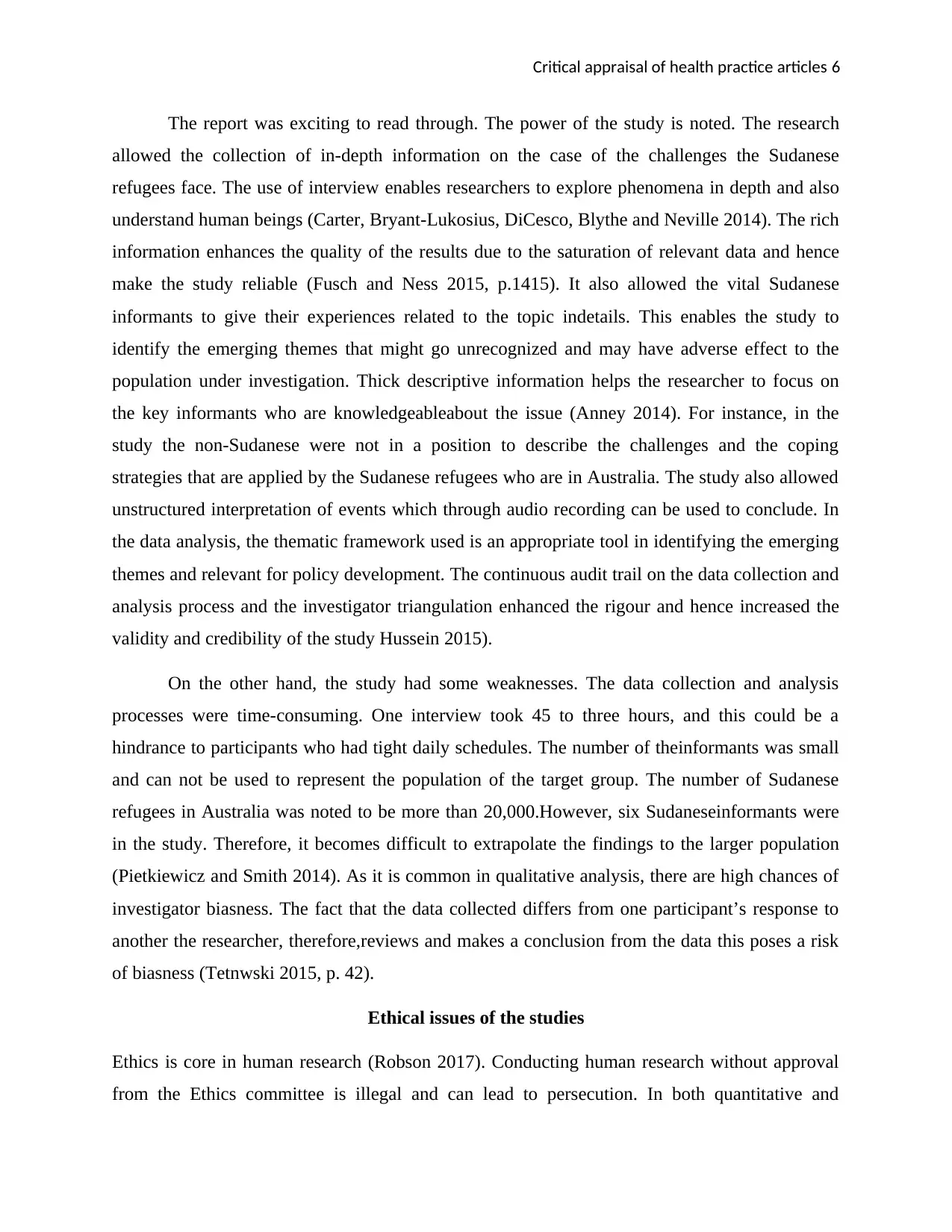
Critical appraisal of health practice articles 6
The report was exciting to read through. The power of the study is noted. The research
allowed the collection of in-depth information on the case of the challenges the Sudanese
refugees face. The use of interview enables researchers to explore phenomena in depth and also
understand human beings (Carter, Bryant-Lukosius, DiCesco, Blythe and Neville 2014). The rich
information enhances the quality of the results due to the saturation of relevant data and hence
make the study reliable (Fusch and Ness 2015, p.1415). It also allowed the vital Sudanese
informants to give their experiences related to the topic indetails. This enables the study to
identify the emerging themes that might go unrecognized and may have adverse effect to the
population under investigation. Thick descriptive information helps the researcher to focus on
the key informants who are knowledgeableabout the issue (Anney 2014). For instance, in the
study the non-Sudanese were not in a position to describe the challenges and the coping
strategies that are applied by the Sudanese refugees who are in Australia. The study also allowed
unstructured interpretation of events which through audio recording can be used to conclude. In
the data analysis, the thematic framework used is an appropriate tool in identifying the emerging
themes and relevant for policy development. The continuous audit trail on the data collection and
analysis process and the investigator triangulation enhanced the rigour and hence increased the
validity and credibility of the study Hussein 2015).
On the other hand, the study had some weaknesses. The data collection and analysis
processes were time-consuming. One interview took 45 to three hours, and this could be a
hindrance to participants who had tight daily schedules. The number of theinformants was small
and can not be used to represent the population of the target group. The number of Sudanese
refugees in Australia was noted to be more than 20,000.However, six Sudaneseinformants were
in the study. Therefore, it becomes difficult to extrapolate the findings to the larger population
(Pietkiewicz and Smith 2014). As it is common in qualitative analysis, there are high chances of
investigator biasness. The fact that the data collected differs from one participant’s response to
another the researcher, therefore,reviews and makes a conclusion from the data this poses a risk
of biasness (Tetnwski 2015, p. 42).
Ethical issues of the studies
Ethics is core in human research (Robson 2017). Conducting human research without approval
from the Ethics committee is illegal and can lead to persecution. In both quantitative and
The report was exciting to read through. The power of the study is noted. The research
allowed the collection of in-depth information on the case of the challenges the Sudanese
refugees face. The use of interview enables researchers to explore phenomena in depth and also
understand human beings (Carter, Bryant-Lukosius, DiCesco, Blythe and Neville 2014). The rich
information enhances the quality of the results due to the saturation of relevant data and hence
make the study reliable (Fusch and Ness 2015, p.1415). It also allowed the vital Sudanese
informants to give their experiences related to the topic indetails. This enables the study to
identify the emerging themes that might go unrecognized and may have adverse effect to the
population under investigation. Thick descriptive information helps the researcher to focus on
the key informants who are knowledgeableabout the issue (Anney 2014). For instance, in the
study the non-Sudanese were not in a position to describe the challenges and the coping
strategies that are applied by the Sudanese refugees who are in Australia. The study also allowed
unstructured interpretation of events which through audio recording can be used to conclude. In
the data analysis, the thematic framework used is an appropriate tool in identifying the emerging
themes and relevant for policy development. The continuous audit trail on the data collection and
analysis process and the investigator triangulation enhanced the rigour and hence increased the
validity and credibility of the study Hussein 2015).
On the other hand, the study had some weaknesses. The data collection and analysis
processes were time-consuming. One interview took 45 to three hours, and this could be a
hindrance to participants who had tight daily schedules. The number of theinformants was small
and can not be used to represent the population of the target group. The number of Sudanese
refugees in Australia was noted to be more than 20,000.However, six Sudaneseinformants were
in the study. Therefore, it becomes difficult to extrapolate the findings to the larger population
(Pietkiewicz and Smith 2014). As it is common in qualitative analysis, there are high chances of
investigator biasness. The fact that the data collected differs from one participant’s response to
another the researcher, therefore,reviews and makes a conclusion from the data this poses a risk
of biasness (Tetnwski 2015, p. 42).
Ethical issues of the studies
Ethics is core in human research (Robson 2017). Conducting human research without approval
from the Ethics committee is illegal and can lead to persecution. In both quantitative and
⊘ This is a preview!⊘
Do you want full access?
Subscribe today to unlock all pages.

Trusted by 1+ million students worldwide
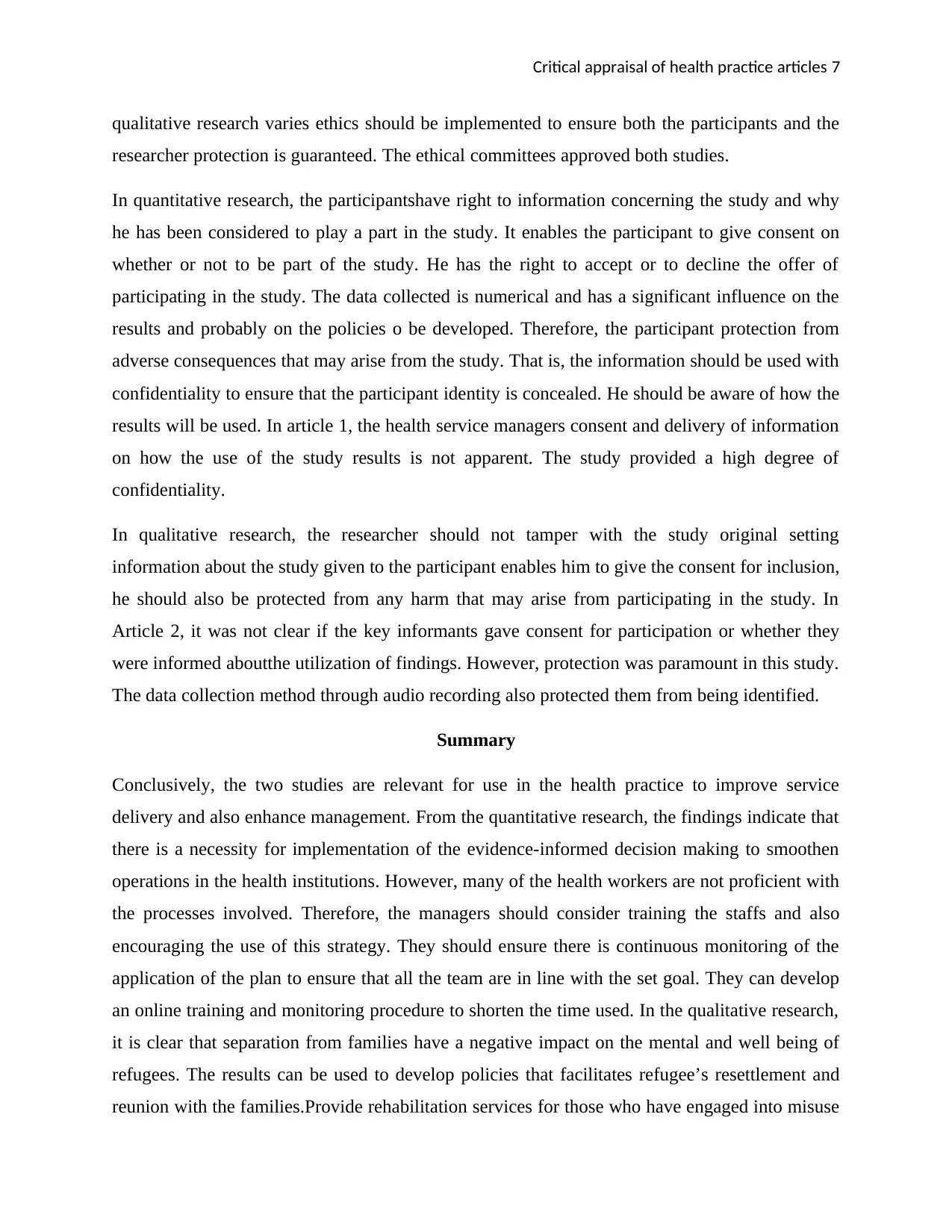
Critical appraisal of health practice articles 7
qualitative research varies ethics should be implemented to ensure both the participants and the
researcher protection is guaranteed. The ethical committees approved both studies.
In quantitative research, the participantshave right to information concerning the study and why
he has been considered to play a part in the study. It enables the participant to give consent on
whether or not to be part of the study. He has the right to accept or to decline the offer of
participating in the study. The data collected is numerical and has a significant influence on the
results and probably on the policies o be developed. Therefore, the participant protection from
adverse consequences that may arise from the study. That is, the information should be used with
confidentiality to ensure that the participant identity is concealed. He should be aware of how the
results will be used. In article 1, the health service managers consent and delivery of information
on how the use of the study results is not apparent. The study provided a high degree of
confidentiality.
In qualitative research, the researcher should not tamper with the study original setting
information about the study given to the participant enables him to give the consent for inclusion,
he should also be protected from any harm that may arise from participating in the study. In
Article 2, it was not clear if the key informants gave consent for participation or whether they
were informed aboutthe utilization of findings. However, protection was paramount in this study.
The data collection method through audio recording also protected them from being identified.
Summary
Conclusively, the two studies are relevant for use in the health practice to improve service
delivery and also enhance management. From the quantitative research, the findings indicate that
there is a necessity for implementation of the evidence-informed decision making to smoothen
operations in the health institutions. However, many of the health workers are not proficient with
the processes involved. Therefore, the managers should consider training the staffs and also
encouraging the use of this strategy. They should ensure there is continuous monitoring of the
application of the plan to ensure that all the team are in line with the set goal. They can develop
an online training and monitoring procedure to shorten the time used. In the qualitative research,
it is clear that separation from families have a negative impact on the mental and well being of
refugees. The results can be used to develop policies that facilitates refugee’s resettlement and
reunion with the families.Provide rehabilitation services for those who have engaged into misuse
qualitative research varies ethics should be implemented to ensure both the participants and the
researcher protection is guaranteed. The ethical committees approved both studies.
In quantitative research, the participantshave right to information concerning the study and why
he has been considered to play a part in the study. It enables the participant to give consent on
whether or not to be part of the study. He has the right to accept or to decline the offer of
participating in the study. The data collected is numerical and has a significant influence on the
results and probably on the policies o be developed. Therefore, the participant protection from
adverse consequences that may arise from the study. That is, the information should be used with
confidentiality to ensure that the participant identity is concealed. He should be aware of how the
results will be used. In article 1, the health service managers consent and delivery of information
on how the use of the study results is not apparent. The study provided a high degree of
confidentiality.
In qualitative research, the researcher should not tamper with the study original setting
information about the study given to the participant enables him to give the consent for inclusion,
he should also be protected from any harm that may arise from participating in the study. In
Article 2, it was not clear if the key informants gave consent for participation or whether they
were informed aboutthe utilization of findings. However, protection was paramount in this study.
The data collection method through audio recording also protected them from being identified.
Summary
Conclusively, the two studies are relevant for use in the health practice to improve service
delivery and also enhance management. From the quantitative research, the findings indicate that
there is a necessity for implementation of the evidence-informed decision making to smoothen
operations in the health institutions. However, many of the health workers are not proficient with
the processes involved. Therefore, the managers should consider training the staffs and also
encouraging the use of this strategy. They should ensure there is continuous monitoring of the
application of the plan to ensure that all the team are in line with the set goal. They can develop
an online training and monitoring procedure to shorten the time used. In the qualitative research,
it is clear that separation from families have a negative impact on the mental and well being of
refugees. The results can be used to develop policies that facilitates refugee’s resettlement and
reunion with the families.Provide rehabilitation services for those who have engaged into misuse
Paraphrase This Document
Need a fresh take? Get an instant paraphrase of this document with our AI Paraphraser
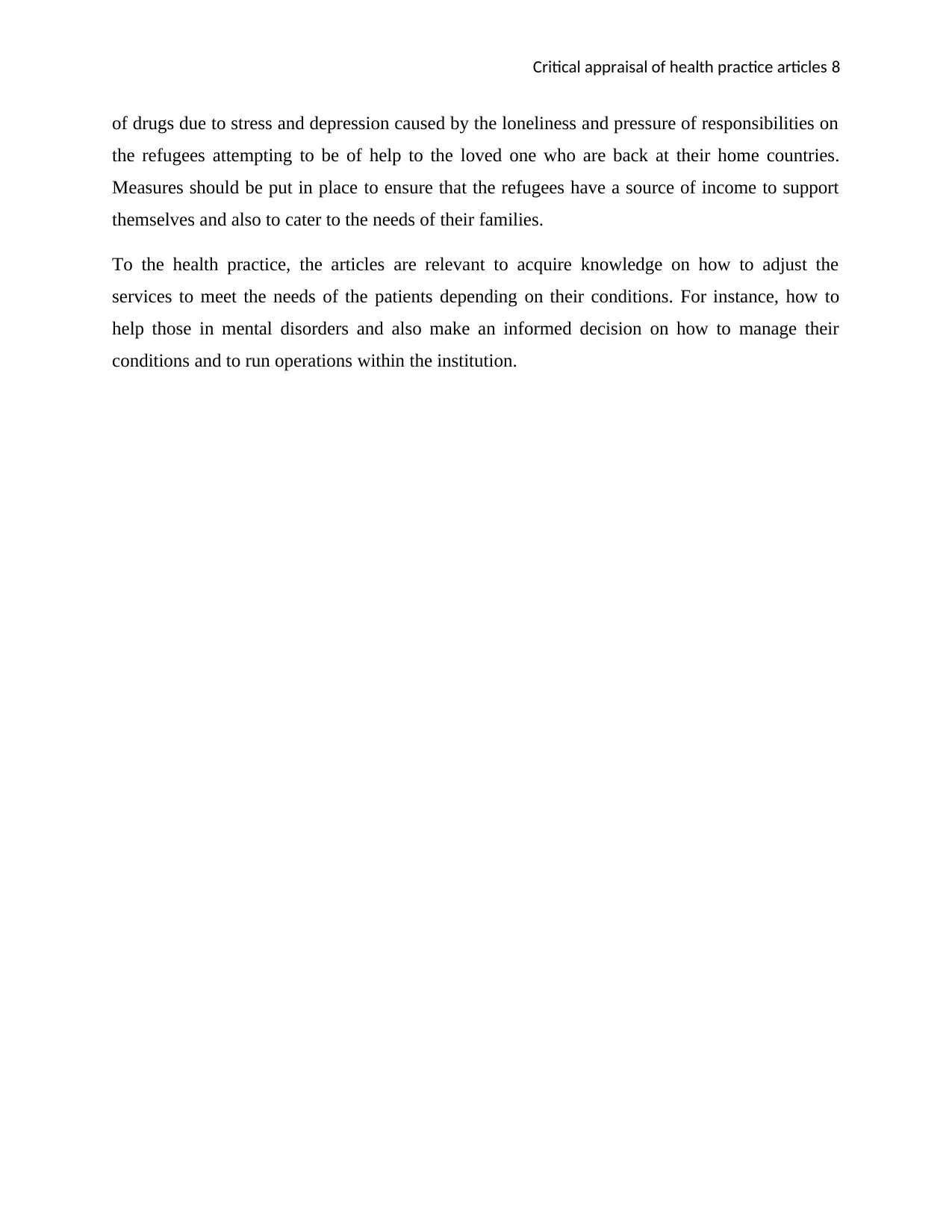
Critical appraisal of health practice articles 8
of drugs due to stress and depression caused by the loneliness and pressure of responsibilities on
the refugees attempting to be of help to the loved one who are back at their home countries.
Measures should be put in place to ensure that the refugees have a source of income to support
themselves and also to cater to the needs of their families.
To the health practice, the articles are relevant to acquire knowledge on how to adjust the
services to meet the needs of the patients depending on their conditions. For instance, how to
help those in mental disorders and also make an informed decision on how to manage their
conditions and to run operations within the institution.
of drugs due to stress and depression caused by the loneliness and pressure of responsibilities on
the refugees attempting to be of help to the loved one who are back at their home countries.
Measures should be put in place to ensure that the refugees have a source of income to support
themselves and also to cater to the needs of their families.
To the health practice, the articles are relevant to acquire knowledge on how to adjust the
services to meet the needs of the patients depending on their conditions. For instance, how to
help those in mental disorders and also make an informed decision on how to manage their
conditions and to run operations within the institution.
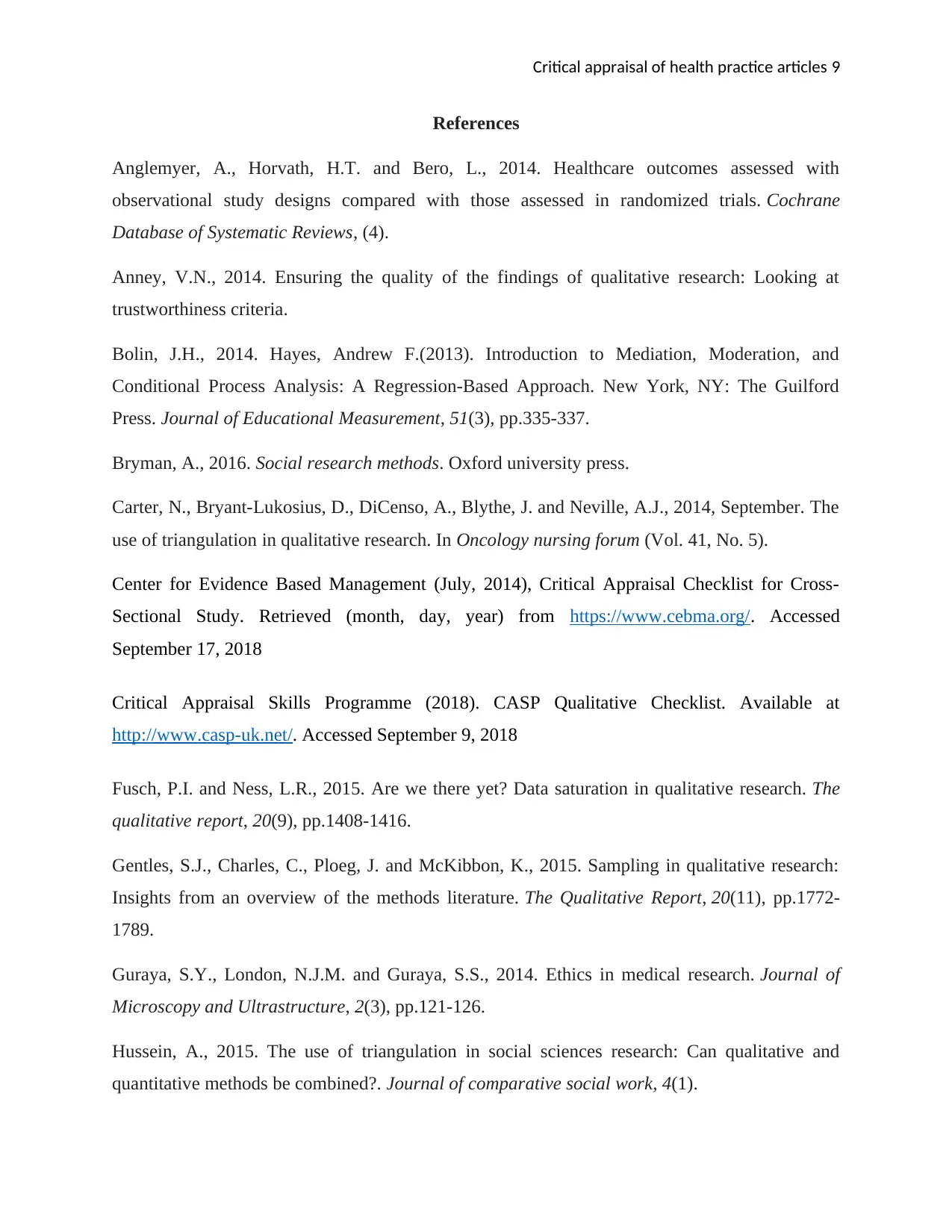
Critical appraisal of health practice articles 9
References
Anglemyer, A., Horvath, H.T. and Bero, L., 2014. Healthcare outcomes assessed with
observational study designs compared with those assessed in randomized trials. Cochrane
Database of Systematic Reviews, (4).
Anney, V.N., 2014. Ensuring the quality of the findings of qualitative research: Looking at
trustworthiness criteria.
Bolin, J.H., 2014. Hayes, Andrew F.(2013). Introduction to Mediation, Moderation, and
Conditional Process Analysis: A Regression‐Based Approach. New York, NY: The Guilford
Press. Journal of Educational Measurement, 51(3), pp.335-337.
Bryman, A., 2016. Social research methods. Oxford university press.
Carter, N., Bryant-Lukosius, D., DiCenso, A., Blythe, J. and Neville, A.J., 2014, September. The
use of triangulation in qualitative research. In Oncology nursing forum (Vol. 41, No. 5).
Center for Evidence Based Management (July, 2014), Critical Appraisal Checklist for Cross-
Sectional Study. Retrieved (month, day, year) from https://www.cebma.org/. Accessed
September 17, 2018
Critical Appraisal Skills Programme (2018). CASP Qualitative Checklist. Available at
http://www.casp-uk.net/. Accessed September 9, 2018
Fusch, P.I. and Ness, L.R., 2015. Are we there yet? Data saturation in qualitative research. The
qualitative report, 20(9), pp.1408-1416.
Gentles, S.J., Charles, C., Ploeg, J. and McKibbon, K., 2015. Sampling in qualitative research:
Insights from an overview of the methods literature. The Qualitative Report, 20(11), pp.1772-
1789.
Guraya, S.Y., London, N.J.M. and Guraya, S.S., 2014. Ethics in medical research. Journal of
Microscopy and Ultrastructure, 2(3), pp.121-126.
Hussein, A., 2015. The use of triangulation in social sciences research: Can qualitative and
quantitative methods be combined?. Journal of comparative social work, 4(1).
References
Anglemyer, A., Horvath, H.T. and Bero, L., 2014. Healthcare outcomes assessed with
observational study designs compared with those assessed in randomized trials. Cochrane
Database of Systematic Reviews, (4).
Anney, V.N., 2014. Ensuring the quality of the findings of qualitative research: Looking at
trustworthiness criteria.
Bolin, J.H., 2014. Hayes, Andrew F.(2013). Introduction to Mediation, Moderation, and
Conditional Process Analysis: A Regression‐Based Approach. New York, NY: The Guilford
Press. Journal of Educational Measurement, 51(3), pp.335-337.
Bryman, A., 2016. Social research methods. Oxford university press.
Carter, N., Bryant-Lukosius, D., DiCenso, A., Blythe, J. and Neville, A.J., 2014, September. The
use of triangulation in qualitative research. In Oncology nursing forum (Vol. 41, No. 5).
Center for Evidence Based Management (July, 2014), Critical Appraisal Checklist for Cross-
Sectional Study. Retrieved (month, day, year) from https://www.cebma.org/. Accessed
September 17, 2018
Critical Appraisal Skills Programme (2018). CASP Qualitative Checklist. Available at
http://www.casp-uk.net/. Accessed September 9, 2018
Fusch, P.I. and Ness, L.R., 2015. Are we there yet? Data saturation in qualitative research. The
qualitative report, 20(9), pp.1408-1416.
Gentles, S.J., Charles, C., Ploeg, J. and McKibbon, K., 2015. Sampling in qualitative research:
Insights from an overview of the methods literature. The Qualitative Report, 20(11), pp.1772-
1789.
Guraya, S.Y., London, N.J.M. and Guraya, S.S., 2014. Ethics in medical research. Journal of
Microscopy and Ultrastructure, 2(3), pp.121-126.
Hussein, A., 2015. The use of triangulation in social sciences research: Can qualitative and
quantitative methods be combined?. Journal of comparative social work, 4(1).
⊘ This is a preview!⊘
Do you want full access?
Subscribe today to unlock all pages.

Trusted by 1+ million students worldwide
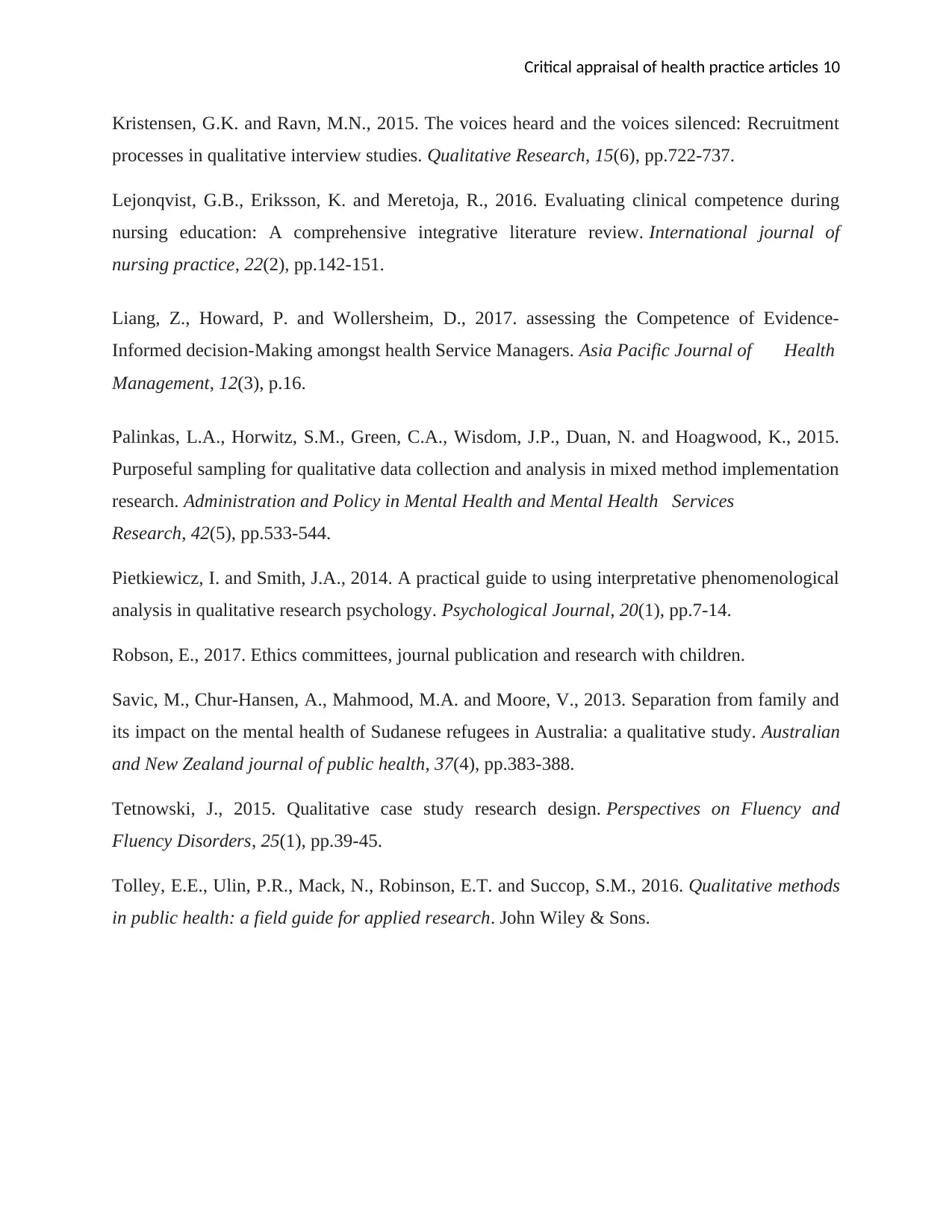
Critical appraisal of health practice articles 10
Kristensen, G.K. and Ravn, M.N., 2015. The voices heard and the voices silenced: Recruitment
processes in qualitative interview studies. Qualitative Research, 15(6), pp.722-737.
Lejonqvist, G.B., Eriksson, K. and Meretoja, R., 2016. Evaluating clinical competence during
nursing education: A comprehensive integrative literature review. International journal of
nursing practice, 22(2), pp.142-151.
Liang, Z., Howard, P. and Wollersheim, D., 2017. assessing the Competence of Evidence-
Informed decision-Making amongst health Service Managers. Asia Pacific Journal of Health
Management, 12(3), p.16.
Palinkas, L.A., Horwitz, S.M., Green, C.A., Wisdom, J.P., Duan, N. and Hoagwood, K., 2015.
Purposeful sampling for qualitative data collection and analysis in mixed method implementation
research. Administration and Policy in Mental Health and Mental Health Services
Research, 42(5), pp.533-544.
Pietkiewicz, I. and Smith, J.A., 2014. A practical guide to using interpretative phenomenological
analysis in qualitative research psychology. Psychological Journal, 20(1), pp.7-14.
Robson, E., 2017. Ethics committees, journal publication and research with children.
Savic, M., Chur‐Hansen, A., Mahmood, M.A. and Moore, V., 2013. Separation from family and
its impact on the mental health of Sudanese refugees in Australia: a qualitative study. Australian
and New Zealand journal of public health, 37(4), pp.383-388.
Tetnowski, J., 2015. Qualitative case study research design. Perspectives on Fluency and
Fluency Disorders, 25(1), pp.39-45.
Tolley, E.E., Ulin, P.R., Mack, N., Robinson, E.T. and Succop, S.M., 2016. Qualitative methods
in public health: a field guide for applied research. John Wiley & Sons.
Kristensen, G.K. and Ravn, M.N., 2015. The voices heard and the voices silenced: Recruitment
processes in qualitative interview studies. Qualitative Research, 15(6), pp.722-737.
Lejonqvist, G.B., Eriksson, K. and Meretoja, R., 2016. Evaluating clinical competence during
nursing education: A comprehensive integrative literature review. International journal of
nursing practice, 22(2), pp.142-151.
Liang, Z., Howard, P. and Wollersheim, D., 2017. assessing the Competence of Evidence-
Informed decision-Making amongst health Service Managers. Asia Pacific Journal of Health
Management, 12(3), p.16.
Palinkas, L.A., Horwitz, S.M., Green, C.A., Wisdom, J.P., Duan, N. and Hoagwood, K., 2015.
Purposeful sampling for qualitative data collection and analysis in mixed method implementation
research. Administration and Policy in Mental Health and Mental Health Services
Research, 42(5), pp.533-544.
Pietkiewicz, I. and Smith, J.A., 2014. A practical guide to using interpretative phenomenological
analysis in qualitative research psychology. Psychological Journal, 20(1), pp.7-14.
Robson, E., 2017. Ethics committees, journal publication and research with children.
Savic, M., Chur‐Hansen, A., Mahmood, M.A. and Moore, V., 2013. Separation from family and
its impact on the mental health of Sudanese refugees in Australia: a qualitative study. Australian
and New Zealand journal of public health, 37(4), pp.383-388.
Tetnowski, J., 2015. Qualitative case study research design. Perspectives on Fluency and
Fluency Disorders, 25(1), pp.39-45.
Tolley, E.E., Ulin, P.R., Mack, N., Robinson, E.T. and Succop, S.M., 2016. Qualitative methods
in public health: a field guide for applied research. John Wiley & Sons.
Paraphrase This Document
Need a fresh take? Get an instant paraphrase of this document with our AI Paraphraser
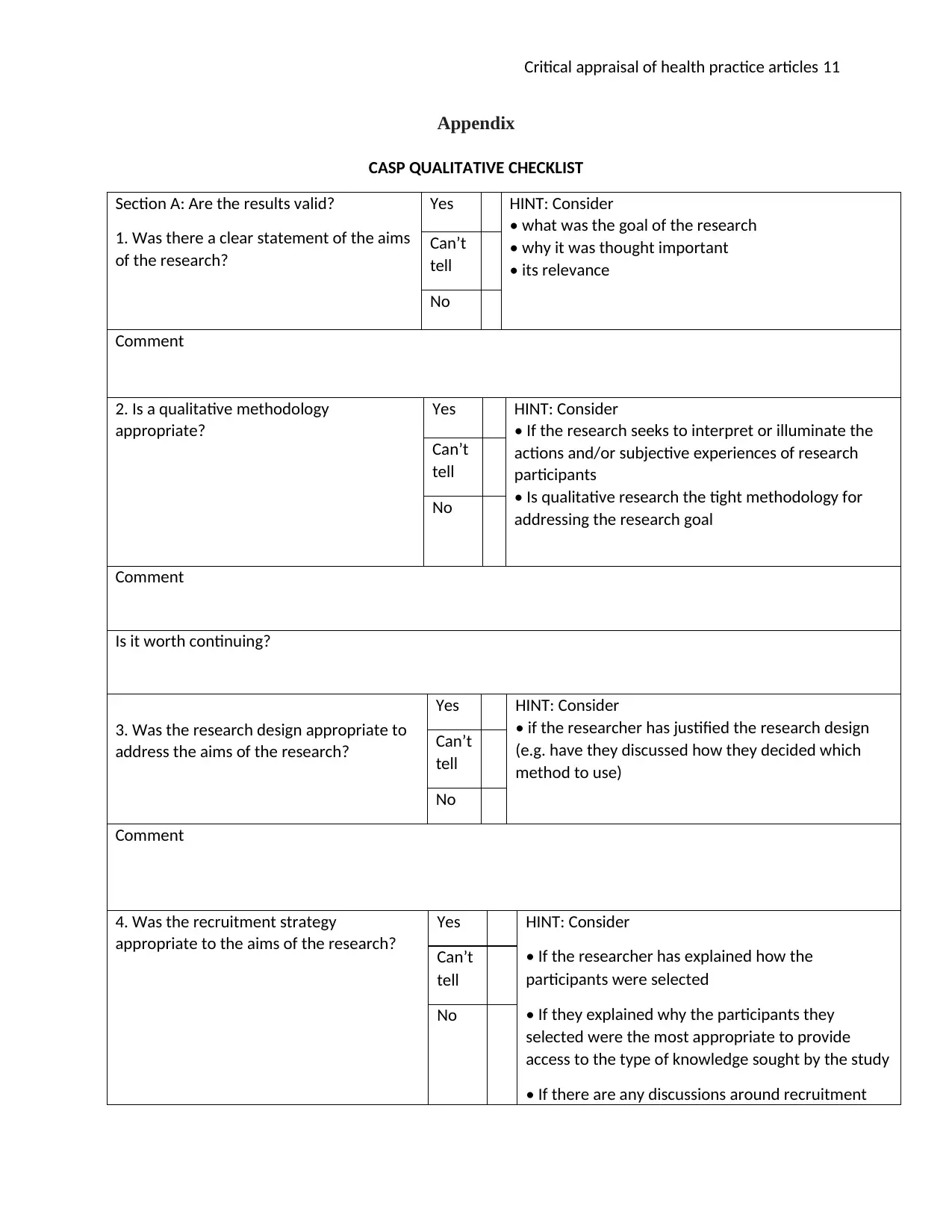
Critical appraisal of health practice articles 11
Appendix
CASP QUALITATIVE CHECKLIST
Section A: Are the results valid?
1. Was there a clear statement of the aims
of the research?
Yes HINT: Consider
• what was the goal of the research
• why it was thought important
• its relevance
Can’t
tell
No
Comment
2. Is a qualitative methodology
appropriate?
Yes HINT: Consider
• If the research seeks to interpret or illuminate the
actions and/or subjective experiences of research
participants
• Is qualitative research the tight methodology for
addressing the research goal
Can’t
tell
No
Comment
Is it worth continuing?
3. Was the research design appropriate to
address the aims of the research?
Yes HINT: Consider
• if the researcher has justified the research design
(e.g. have they discussed how they decided which
method to use)
Can’t
tell
No
Comment
4. Was the recruitment strategy
appropriate to the aims of the research?
Yes HINT: Consider
• If the researcher has explained how the
participants were selected
• If they explained why the participants they
selected were the most appropriate to provide
access to the type of knowledge sought by the study
• If there are any discussions around recruitment
Can’t
tell
No
Appendix
CASP QUALITATIVE CHECKLIST
Section A: Are the results valid?
1. Was there a clear statement of the aims
of the research?
Yes HINT: Consider
• what was the goal of the research
• why it was thought important
• its relevance
Can’t
tell
No
Comment
2. Is a qualitative methodology
appropriate?
Yes HINT: Consider
• If the research seeks to interpret or illuminate the
actions and/or subjective experiences of research
participants
• Is qualitative research the tight methodology for
addressing the research goal
Can’t
tell
No
Comment
Is it worth continuing?
3. Was the research design appropriate to
address the aims of the research?
Yes HINT: Consider
• if the researcher has justified the research design
(e.g. have they discussed how they decided which
method to use)
Can’t
tell
No
Comment
4. Was the recruitment strategy
appropriate to the aims of the research?
Yes HINT: Consider
• If the researcher has explained how the
participants were selected
• If they explained why the participants they
selected were the most appropriate to provide
access to the type of knowledge sought by the study
• If there are any discussions around recruitment
Can’t
tell
No
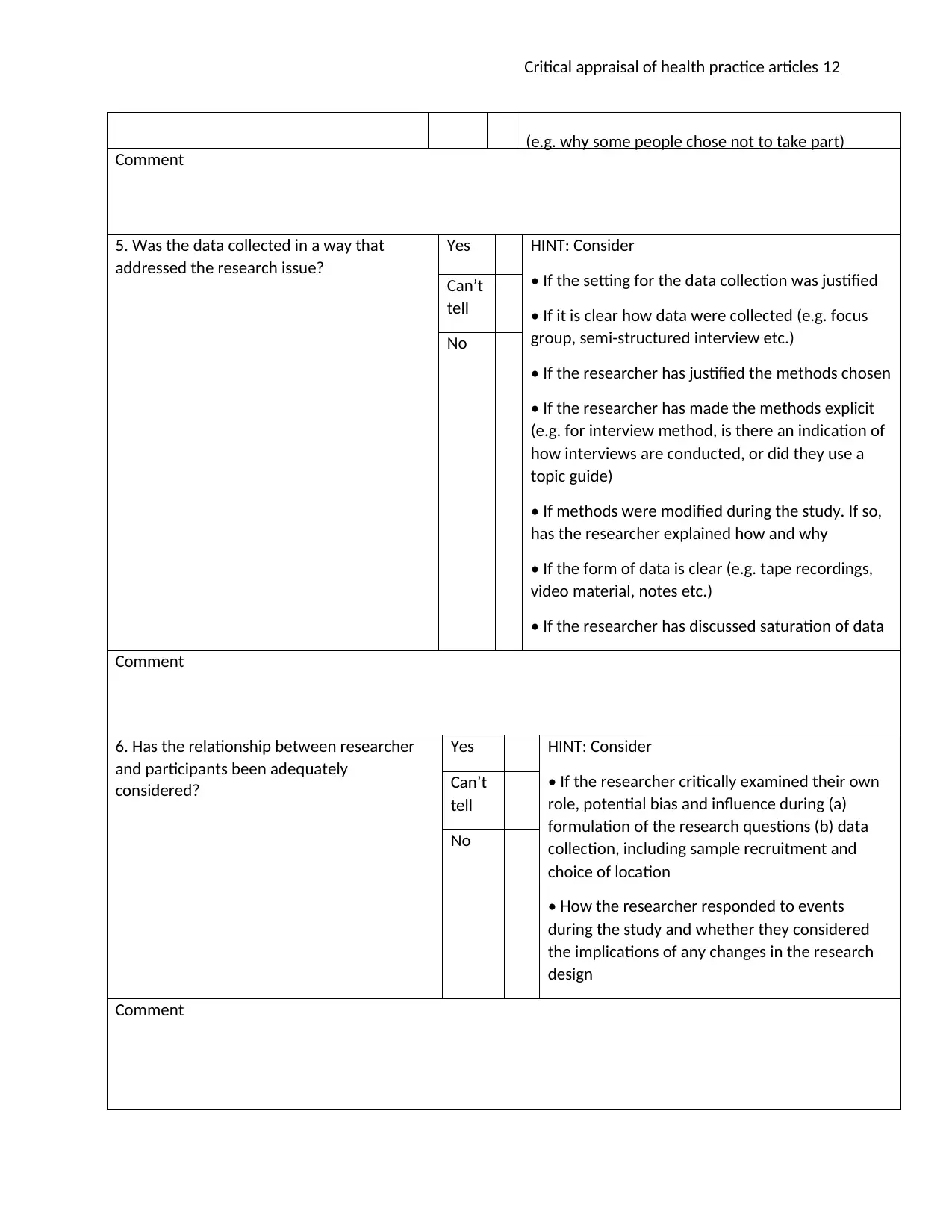
Critical appraisal of health practice articles 12
(e.g. why some people chose not to take part)
Comment
5. Was the data collected in a way that
addressed the research issue?
Yes HINT: Consider
• If the setting for the data collection was justified
• If it is clear how data were collected (e.g. focus
group, semi-structured interview etc.)
• If the researcher has justified the methods chosen
• If the researcher has made the methods explicit
(e.g. for interview method, is there an indication of
how interviews are conducted, or did they use a
topic guide)
• If methods were modified during the study. If so,
has the researcher explained how and why
• If the form of data is clear (e.g. tape recordings,
video material, notes etc.)
• If the researcher has discussed saturation of data
Can’t
tell
No
Comment
6. Has the relationship between researcher
and participants been adequately
considered?
Yes HINT: Consider
• If the researcher critically examined their own
role, potential bias and influence during (a)
formulation of the research questions (b) data
collection, including sample recruitment and
choice of location
• How the researcher responded to events
during the study and whether they considered
the implications of any changes in the research
design
Can’t
tell
No
Comment
(e.g. why some people chose not to take part)
Comment
5. Was the data collected in a way that
addressed the research issue?
Yes HINT: Consider
• If the setting for the data collection was justified
• If it is clear how data were collected (e.g. focus
group, semi-structured interview etc.)
• If the researcher has justified the methods chosen
• If the researcher has made the methods explicit
(e.g. for interview method, is there an indication of
how interviews are conducted, or did they use a
topic guide)
• If methods were modified during the study. If so,
has the researcher explained how and why
• If the form of data is clear (e.g. tape recordings,
video material, notes etc.)
• If the researcher has discussed saturation of data
Can’t
tell
No
Comment
6. Has the relationship between researcher
and participants been adequately
considered?
Yes HINT: Consider
• If the researcher critically examined their own
role, potential bias and influence during (a)
formulation of the research questions (b) data
collection, including sample recruitment and
choice of location
• How the researcher responded to events
during the study and whether they considered
the implications of any changes in the research
design
Can’t
tell
No
Comment
⊘ This is a preview!⊘
Do you want full access?
Subscribe today to unlock all pages.

Trusted by 1+ million students worldwide
1 out of 16
Related Documents
Your All-in-One AI-Powered Toolkit for Academic Success.
+13062052269
info@desklib.com
Available 24*7 on WhatsApp / Email
![[object Object]](/_next/static/media/star-bottom.7253800d.svg)
Unlock your academic potential
Copyright © 2020–2025 A2Z Services. All Rights Reserved. Developed and managed by ZUCOL.





